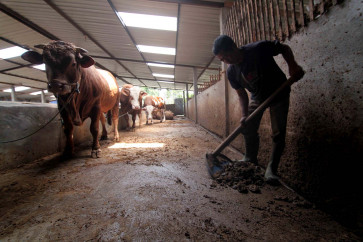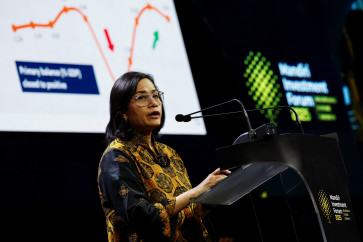Popular Reads
Top Results
Can't find what you're looking for?
View all search resultsPopular Reads
Top Results
Can't find what you're looking for?
View all search resultsHIV and a lost generation
An explosion of HIV within the general public could stop Indonesia’s millennium development goals (MDG’s) on child mortality in its tracks, and threatens a “lost generation”
Change text size
Gift Premium Articles
to Anyone
A
n explosion of HIV within the general public could stop Indonesia’s millennium development goals (MDG’s) on child mortality in its tracks, and threatens a “lost generation”.
A recent HIV screening study of 403 pregnant women drawn from the general public in Bali showed 1.24 percent of the women were HIV positive; and they did not know it.
Dinar Lubis of the Kerti Praja Foundation, which has worked with HIV and AIDS patients since 1992, says this figure is “really serious”.
“If this figure of 1.24 percent extends over the whole Bali population, we have a huge problem. Child infant mortality statistics due to HIV would make it very difficult to achieve the MDGs. I am afraid that within five years, HIV will become one of the infant mortality causes. Currently these are nutrition, poverty and poor water quality,” says Lubis, explaining that as traditional infant mortality causes are being addressed, HIV may become a counter balance, with causes of infant mortality shifting from the current factors to HIV, making MDG targets impossible.
I’m human: A poster stating “Whether I’m HIV+ or not I’m Human” is displayed during the International Congress on AIDS in Asia and the Pacific (ICAAP) in Bali last year. JP/Zul T. Edoardo
While 1.24 percent may appear negligible, Lubis explains the actual figure becomes significant when
extrapolated across the general population. “The study was done only by private midwives, not in public hospitals. I was really surprised by the data that’s really high. It means that out of 56,000 women who would become pregnant in Bali in a year, 670 would be HIV positive. That means between 225 and 335 babies would be born HIV positive,” explains Lubis.
Consultant pediatrician Ketut Dewi Kumara Wati of the Allergy Immunology Section, Child Health Department Sanglah Hospital/ Medical School of Udayana University, Denpasar, is deeply concerned about the results of the HIV screening study; it represents a quantum leap in HIV positive mothers and the potential for babies born with the disease.
“The fact that I don’t know where the 300 babies live or where they go to seek help means we may not able to identify them,” says Dewi in an email, pointing out that if HIV positive pregnant women receive preventative treatment during pregnancy, at birth and during breast feeding, risks of infection to their babies drop from up to 65 percent to just 1 or 2 percent.
Dewi adds HIV is a mobile disease. “HIV infection affects various parts of society. It affects people from villages who come seeking jobs in “richer” areas, in Bali, mostly in tourism areas.
These people are far from their families, and when they return to their villages, they transfer the disease to their partners who really have no idea about HIV or the impact of its infection, explains Dewi.
Telling a new mother her child is HIV positive is a gut wrenching experience for Dewi who to date has worked with 142 babies, almost half receiving life saving intervention programs while in utero.
“In some cases, the women know they are victims. In other cases they are blamed for the disease by the husband’s family members... Also the woman’s husband may be severely ill [with AIDS] so if she wants to argue about why he has the disease it only adds to the problem, it doesn’t offer solutions.
And then she has to face sick children, while sick herself. Women need support to face this,” says Dewi of the families she counsels and treats on a regular basis.
Safety first: A volunteer explains how to use condoms on the sidelines of the ICAAP meeting. The use of condoms is still believed to be the most effective way to prevent HIV. JP/Zul T. Edoardo
Compounding the spread of HIV and risks to families is ignorance of the disease, says Dewi.
“There are groups in the adult population who continue to ignore the lesson learned from HIV. The sad fact is, they think they are the only ones who will suffer the consequences. Other members of the family [or family members to be], such as their partners and their offspring will be affected too,” says Dewi.
Like Sanglah Hospital, Kerti Praja Foundation also cares for HIV positive children, supporting the medical work of the hospital with family support for the 37 babies and toddlers with HIV currently with the foundation.
“For the past three months we have had a baby die each month,” says Lubis of the HIV tragedy
now impacting on Bali’s general population.
Housewives and their children are rapidly becoming an at risk group within HIV transmission. Lubis explains this is due to low condom use by husbands visiting sex workers, engaging in same sex relationships, again without condoms or injecting drugs such as heroin with infected needles.
These men carry home HIV to their unsuspecting wives, or in some cases, says Lubis, to wives aware their partner is HIV positive, but without the power to demand either sexual abstinence or condom use.
“The majority of babies in our program were born to housewives, often the widows of husbands that have died from HIV. There was one woman whose husband died of AIDS. She did not know he had the disease.
Her child was also infected through birth. She only found out about the disease when her husband died and she went to be checked,” says Lubis.
The chance of men picking up — or transmitting HIV — in Bali’s sex work sites is extremely high.
According to a December 2009 Health Department study, just 33.6 percent of sex workers said they “always use” condoms, against a massive 48.9 percent saying they “often use” condoms.
Within the study 2.1 percent of workers “never used” condoms. This year the figures “always using” condoms has risen to more than 40 percent, according to Lubis, suggesting government and NGO mitigation programs are biting.
Survival kit: Bidia Deperthes, a technical advisor working for the United Nations Population Fund (UNFPA), shows two packages of condoms in Jakarta, before the Bali congress. JP/R. Berto Wedhatama
Again these figures need to be seen against the backdrop of HIV infection among sex workers. In some areas of Bali, almost half of all female sex workers are HIV positive; in other areas this figure drops to just over one percent.
The average for the province of HIV positive sex workers is 23.2 percent, a rise of 22 percent in just nine years, according to data from Kerti Praja Foundation.
According to Lubis, the earlier people discover they are HIV positive, the quicker life prolonging treatment can begin, this is particularly so in babies.
However mandatory HIV screening for pregnant women, while prolonging health for mother and baby has consequences for wives testing positive almost as disastrous as the deadly disease itself.
“In my mind there are two things. I suggest every pregnant woman should have a HIV test. But I also feel this is very difficult because if she is HIV positive I am afraid of the stigma she faces… For a woman, if her test is positive, it will destroy her [family] life, but we need to encourage testing for babies’ health,” says Lubis.
The levels of HIV being seen within Bali’s general population, while still well below that of Papua, indicates a potential health nightmare for the province of just 3.5 million.
“My biggest fear is grounded in the 1.24 percent in 403 pregnant women data, because of the potential numbers of babies born with HIV…We are becoming afraid we will see a lost generation; one family, all with AIDS, so a complete generation lost. If we don’t do more on even greater HIV prevention, the HIV epidemic wave will become a HIV tsunami,” says Lubis.
Dewi also fears for a “lost generation” if communities fail to recognize and address the dangers of HIV and its transference through unsafe sex and/or intravenous drug use. She calls also for compassion for the victims, particularly child victims.
“If we do not learn from the lesson, …then the problem will continue, in which the uninfected will continue to ignore, the infected people will continue to spread the virus, and we will lose our new generation. What type of a society are we who ignore the children?” asks Dewi.
On the hard data, Dewi says, “If there are 300 babies born from HIV women per year in Bali, this means that 25 babies per month, or approximately one baby per day. We can care for them … The problem is, these people may not come to the hospital. The number in the hospital represents only the peak, not the whole mountain.”
The issue there is the readiness of the community to find out whether they are infected, so health providers can deliver a prevention program, Dewi says, reiterating that when pregnant women come under the (HIV) prevention program, infection risks in babies falls to just 1 or 2 percent.












